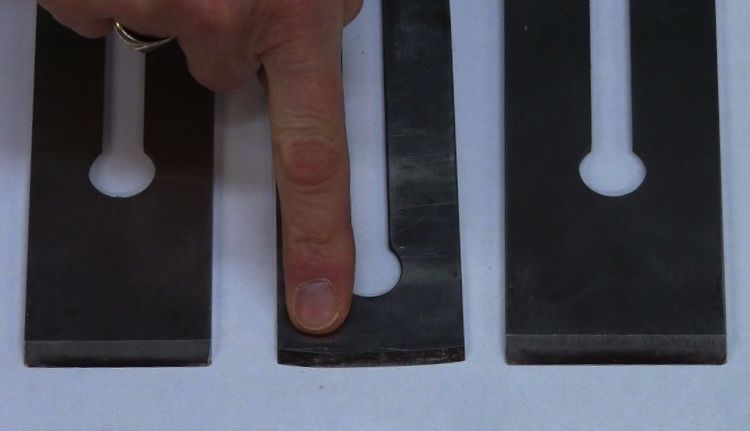We may receive a commission when you use our affiliate links. However, this does not impact our recommendations.

The irons for #4, #5, and #7 planes. The #5 is cambered. The others are straight across with rounded corners.
Roughing, flattening and smoothing lumber are fundamental hand tool woodworking skills. Before you can properly perform these tasks, you need to know how to shape your plane irons.The shape of the edge of a bench plane iron across its width is determined by its function. For roughing, the edge of the iron should be cambered (curved along a shallow arc). For flattening and smoothing, the edge should be straight across.
I use a medium-length #5 jack plane for roughing, a long #6 or #7 jointer plane for flattening, and a short #3 or #4 smoother plane for smoothing (this is the Stanley numbering system, but the names apply to any medium, long, and short planes). Roughing calls for fast stock removal, where the resulting surface is not the main concern. Flattening then cleans up that surface. Smoothing is the final touch to make the surface silky smooth.
Using a cambered iron means the jack plane can be set for a heavier, more aggressive cut to complete the roughing job faster. It takes a shaving that is thick in the center and thin at the edges, leaving a scalloped surface. At its heaviest, a roughing plane may be scooping out shavings that are more like wood chips, nearly 1/16″ thick at the center.
Flattening and smoothing are much finer operations. For faster surface coverage, their irons are shaped wide and flat. However, the corners should be eased to avoid leaving plane tracks in overlapping passes (streaks in the wood left by sharp corners digging in).
New plane irons come from the factory ground straight across. This leaves it to the woodworker to shape the edge according to individual preference.
Cambering a new iron requires removing a fair amount of metal. It can be done completely by hand, but is time consuming. It’s also a lot of wear on a sharpening stone. This is better done with a grinder, either hand-cranked or powered. Just be sure to quench the metal frequently to keep it cool and avoid damaging the temper.
The iron should be cambered to a radius of 8-12″. It doesn’t need to be a perfectly smooth curve, since this is for a roughing tool. Once shaped, maintain the curve thereafter as you sharpen it.
Ease the corners of jointer and smoother irons during sharpening, either rounding them or tapering them. This requires removing only a small amount of metal. To round the corners, tip the iron gently up on each corner and grind it in small circles on the sharpening stone until the corner has a smoothly rounded radius of 1/16-1/8″. Repeat this through the sharpening grits.
To taper the corners, pitch the iron up a bit on each side, apply pressure just on that side, and grind just that section, about 1/2″ wide. Taper each side back 1/32-1/16″ from the edge. Repeat this through the sharpening grits.
Both variations of this will take shavings that are the same thickness through the flat center of the cut, then feather off at the sides. Rounded corners will take shavings that feather off sharply, tapered corners will take shavings that feather off more gradually. The surface left behind will show this feathering as well, so use overlapping passes of the flat portion of the iron to take them down to a uniform, flat surface.
Learn the basics of hand tool woodworking in Steve Branam’s Popular Woodworking University course, Intro to Hand Tools.
Here are some supplies and tools we find essential in our everyday work around the shop. We may receive a commission from sales referred by our links; however, we have carefully selected these products for their usefulness and quality.








